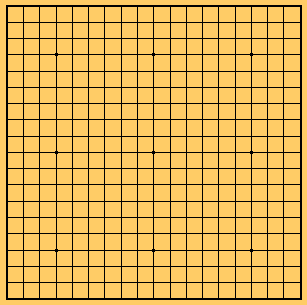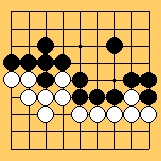Introduction
to the Game of Go and the Rules
(Up to Go
AI)
A Brief Background
Go (also Igo) is the Japanese name for an ancient
board game that originated in China between 2000 to 3000 years
ago. The name for the game in Chinese is weiqi (pronounced way-chee). This means, roughly, "surrounding
game." In Korean, the name is Baduk (pronounced bah-dook,
not bah-duhk). In Taiwan, the game is referred to
as "Goe."
The game spread from China to Korea, and then it most likely spread
to Japan from Korea. Stories talk about a Korean buddhist monk who
sailed the ocean to bring the game to the Japanese royal courts.
The modern rules and strategy were developed in Japan. Today, the
game is played by people all over the world. Some estimate that more than 100 million people play this game.
The Basic
Rules
NOTE: These are the main rules used in modern
Japan and Korea.
The main goal in Go is to surround more unoccupied areas of
the game board ("territory") than the opponent. Unlike
Chess, the opponent is not eradicated or destroyed. Rather, the
two players seek to coexist on the board, leaving one player
with more.
 The
game is usually played on a 19 x 19 grid, which is the standard
tournament size, but other sized game boards are used as well. The
most popular alternative sizes are 9 x 9 and 13 x 13. Boards smaller
than 9 x 9 are usually too small and cramped, and boards larger
than 19 x 19 are usually too unwieldy. The dots are simply visual
reference points, and do not affect play.
The
game is usually played on a 19 x 19 grid, which is the standard
tournament size, but other sized game boards are used as well. The
most popular alternative sizes are 9 x 9 and 13 x 13. Boards smaller
than 9 x 9 are usually too small and cramped, and boards larger
than 19 x 19 are usually too unwieldy. The dots are simply visual
reference points, and do not affect play.
There are two players, one playing White and the other playing
Black. Black moves first, except in handicap games, and the players
play on alternating turns. Each turn, a player places one piece
(a "stone") onto an intersection (not the square) of the
board. Edges and corners are also playable intersections. The intersections
are called "points." Once placed, the stones are never
moved again, except when captured, which will be explained
shortly.
 A
played stone has a certain number of liberties. The liberties
are the number of lines extending from a stone. In diagram, which
shows a partial view of a go board, stone A has four
liberties, stone B has three, and stone C has two. D would be one of the liberties of A.
A
played stone has a certain number of liberties. The liberties
are the number of lines extending from a stone. In diagram, which
shows a partial view of a go board, stone A has four
liberties, stone B has three, and stone C has two. D would be one of the liberties of A.
A group of adjacent friendly stones (stones of the same color)
share liberties. That group is called a string. The stones,
however, must be directly adjacent in order to form a linked group;
diagonals do not count. So, if a black stone were to be at D,
then A and D would form a string with six liberties
total. The two stones are now an inseparable unit, a string.
 Liberties
are reduced by adjacent enemy stones. If a player plays a
stone such that an enemy group has no more liberties (the enemy
is "surrounded"), that player is said to have captured
the enemy group, and the enemy group is removed from the board and
given to the player to hold as prisoner. Each prisoner piece
counts as one point towards the score of the player that holds it.
In the picture, White has captured the four triangled Black stones,
which are removed as White's prisoners. Stone A is not captured,
and it is separate from the other Black group.
Liberties
are reduced by adjacent enemy stones. If a player plays a
stone such that an enemy group has no more liberties (the enemy
is "surrounded"), that player is said to have captured
the enemy group, and the enemy group is removed from the board and
given to the player to hold as prisoner. Each prisoner piece
counts as one point towards the score of the player that holds it.
In the picture, White has captured the four triangled Black stones,
which are removed as White's prisoners. Stone A is not captured,
and it is separate from the other Black group.
 There
are only a few illegal moves in go, but one of them is this:
most directly suicidal moves are illegal. In the picture to the
right, both A or B are illegal moves for White. They
are perfectly legal for Black.
There
are only a few illegal moves in go, but one of them is this:
most directly suicidal moves are illegal. In the picture to the
right, both A or B are illegal moves for White. They
are perfectly legal for Black.
 The
game essentially ends when both players agree that the score will
not change any more. This is generally when the borders have
all been solidified. The score for each player is counted as follows:
count the number of empty intersections that the player controls.
To that number, add the number of prisoners that player holds. This
is the raw score of the player. Traditionally -- since Black has
the advantage of the first move -- White is given a certain number
of points, usually ranging between 5.5 to 7.5, depending on the
tournament. The most common komi is 6.5 points. This is called komi in Japanese. (The half point is included to prevent
ties.) Assuming that there are no prisoners, in the finished game
shown to the left, Black has 32 points, and White has 28.5 (assuming
a 6.5 point komi). So, Black wins by 3.5 points.
The
game essentially ends when both players agree that the score will
not change any more. This is generally when the borders have
all been solidified. The score for each player is counted as follows:
count the number of empty intersections that the player controls.
To that number, add the number of prisoners that player holds. This
is the raw score of the player. Traditionally -- since Black has
the advantage of the first move -- White is given a certain number
of points, usually ranging between 5.5 to 7.5, depending on the
tournament. The most common komi is 6.5 points. This is called komi in Japanese. (The half point is included to prevent
ties.) Assuming that there are no prisoners, in the finished game
shown to the left, Black has 32 points, and White has 28.5 (assuming
a 6.5 point komi). So, Black wins by 3.5 points.
The Ko Rule
 The
most complicated rule is the rule for ko, which is a Japanese
word meaning something like "everlasting." Consider the
following position to the right. Let's say that it is Black's turn.
If Black plays at A (this is legal because Black is capturing
White's stone at B, which means that his stone he played
still has one liberty), then White could recapture at B (Black
captured the White stone B, so the point is now empty). Then,
Black could recapture at A, and White could...
The
most complicated rule is the rule for ko, which is a Japanese
word meaning something like "everlasting." Consider the
following position to the right. Let's say that it is Black's turn.
If Black plays at A (this is legal because Black is capturing
White's stone at B, which means that his stone he played
still has one liberty), then White could recapture at B (Black
captured the White stone B, so the point is now empty). Then,
Black could recapture at A, and White could...
This could go on forever. So, there is a rule to prevent
such everlasting repitition. This formation (and its basic variations)
are known as the ko, so the rule is known as the ko rule.
If Black or White captures in a ko, then the opponent can't
just recapture. Instead, the opponent has to play elsewhere first,
and only later can the opponent return to capture the ko
(assuming that the first player doesn't connect the ko)..
Often, this "in between move" is a threat (to capture,
or do something damaging) which tries to cause the first player
to answer the threat instead of connecting the ko. In this
case, this threat is known as a ko threat.
Life and Death
This last topic is not really a rule, but a crucial consequence
of the rules. Because suicide is illegal, the following Black
group is uncapturable, no matter what White tries to do.

Both of the empty spaces inside the Black group are illegal moves
for White, and since White can only play one move at a time, White
can never capture Black (unless Black feels stupid, a bit generous,
or both and fills in one of the spaces). Each of the two completely
surrounded spaces is called an eye, and any group
that has at least two eyes is alive. The opposite of
life, of course, is death. Any group, such as the following
Black group, that can't make two eyes is dead.

Often, players will simply allow dead groups to stay on the
board until the end of the game (without actually capturing
them), with the understanding that they are dead and that the capturing
details don't actually need to be worked out. This is often true
of small scattered stones in enemy territory. After the game is
finished and counting is to begin, the dead groups are removed
and simply counted as prisoners.
This life and death aspect adds whole new strategic and tactical
dimensions, and computers are still not able to solve even this
small - but important - portion of the game as well as top human
players.
With some practice, the rules of the game become clearer and easier
to understand instinctively. There are many basic computer programs
available that allow you to practice playing go. The rules
usually only take a few hours to master completely, but the
strategy is complex enough that several millenia of study has
still not solved the game. The visual nature of the game, as
well as the vastness of its possibilities, makes it difficult for
any computer to play it to any high degree of ability.
This game is a double blessing in that humans will reign as champions
over computers for decades, perhaps centuries to come, but also
in that this game provides an active and controlled environment
in which to test exciting new techniques for Artificial Intelligence.

